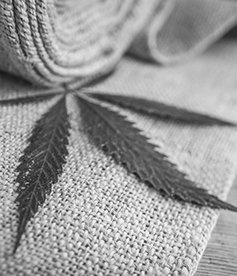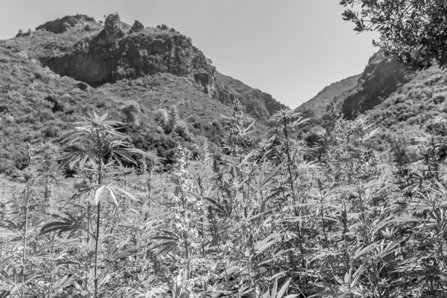History of Marijuana & Cannabis Use and Abuse

- 6000 BC: Cannabis seeds used for food in China.
- 4000 BC: Textiles made of hemp are used in China. (Pharmacotheon)
- Circa 2700 BC: First recorded use of cannabis as medicine in Chinese pharmacopeia. In every part of the world, humankind has used cannabis for a wide variety of health problems.
- 1500 BC: Cannabis cultivated in China for food and fiber.
- 1500 BC: Scythians cultivate cannabis and use it to weave fine hemp cloth. (Sumach 1975)
- 1200-800 BC: Cannabis is mentioned in the Hindu sacred text Atharvaveda (Science of Charms) as “sacred grass”—one of the five sacred plants of India. It is used medicinally and ritually as an offering to Shiva.
- 700-600 BC: The Zoroastrian Zend-Avesta, an ancient Persian religious text of several hundred volumes, and said to have been written by Zarathustra (Zoroaster), refers to bhang as Zoroaster’s “good narcotic.” (Vendidad or The Law against Demons)
- 700-300 BC: Scythian tribes leave Cannabis seeds as offerings in royal tombs.
- 500 BC: Scythian couple die and are buried with two small tents covering censers. Attached to one tent stick was a decorated leather pouch containing wild Cannabis seeds. This closely matches the stories told by Herodotus. The gravesite, discovered in the late 1940s, was in Pazryk, northwest of the Tien Shan Mountains in modern-day Kazakhstan.
- 500 BC: Hemp is introduced into Northern Europe by the Scythians. An urn containing leaves and seeds of the cannabis plant, unearthed near Berlin, is dated about this time.
- 500-100 BC: Hemp spreads throughout Northern Europe.
- 430 BC: Herodotus reports on both ritual and recreation use of cannabis by the Scythians. (Herodotus—The Histories 430 BC. Trans. G. Rawlinson)
- 100 BC-0: The psychotropic properties of cannabis are mentioned in the newly compiled Herbal Pen Ts’ao Ching which is attributed to an emperor.
- 0-100 AD: Construction of Samaritan gold and glass paste stash box for storing hashish, coriander, or salt, buried in Siberian tomb.
- 70: Dioscorides mentions the use of cannabis as a Roman medicament.
- 170: Galen (Greek physician in the Roman empire) alludes to the psychoactivity of cannabis seed confections.
- 500-600: The Jewish Talmud mentions the euphoriant properties of cannabis. (Abel 1980)
- 900-1000: Scholars debate the pros and cons of eating hashish. Use spreads throughout Arabia.
- 1090-1256: In Khorasan, Persia, Hasan ibn al-Sabbah (“the Old Man of the Mountain”) recruits followers to commit assassinations. Legends develop around their supposed use of hashish. These legends are some of the earliest written tales of the discovery of the inebriating powers of cannabis and the supposed use of hashish.
- 1200s: Cannabis is introduced in Egypt during the reign of the Ayyubid dynasty on the occasion of the flooding of Egypt by mystic devotees coming from Syria. (M.K. Hussein 1957–Soueif 1972)

- Early 1200s: Hashish smoking very popular throughout the Middle East.
- 1155-1221: Persian legend of Sufi master Sheik Haydar of Khorasan’s personal discovery of cannabis and its subsequent spread to Iraq, Bahrain, Egypt, and Syria. Another of the earliest written narratives of the use of cannabis as an inebriant.
- 1231: Hashish introduced to Iraq in the reign of Caliph Mustansir. (Rosenthal 1971)
- 1271-1295: Journeys of Marco Polo in which he gives secondhand reports of the story of Hasan ibn al-Sabbah and his “assassins” using hashish. First time reports of cannabis have been brought to the attention of Europe.
- 1300s: The oldest monograph on hashish, Zahr al-‘arish fi tahrim al-hashish, was written. It has since been lost.
- 1300s: Ibn al-Baytar of Spain provides a description of psychoactive cannabis.
- 1300s: Arab traders bring Cannabis to the Mozambique coast of Africa.
- 1378: Ottoman, Emir Soudoun Scheikhouni issues one of the first edicts against the eating of hashish.
- 1526: Babur Nama, the first emperor and founder of the Mughal Empire, learned of hashish in Afghanistan.
- Mid-1600s: The epic poem, Benk u Bode, by the poet Mohammed Ebn Soleiman Foruli of Baghdad, deals allegorically with a dialectical battle between wine and hashish.
- 1700s: Use of hashish, alcohol, and opium spreads among the population of occupied Constantinople.
- Late-1700s: Hashish becomes a major trade item between Central Asia and South Asia.
- 1809: Antoine Sylvestre de Sacy, a leading Arabist, reveals the etymology of the words “assassin” and “hashishin.”
- 1840: In America, medicinal preparations with a Cannabis base are available. Hashish is available in Persian pharmacies.
- 1843: Le Club des Hachichins, or “Hashish Eater’s Club,” established in Paris.
- After 1850: Hashish appears in Greece.
- 1856: British tax ganja and charas trade in India.
- 1870-1880: First reports of hashish smoking on the Greek mainland.
- 1875: Cultivation for hashish introduced to Greece.
- 1877: Kerr reports on Indian ganja and charas trade.
- 1890: Greek Department of Interior prohibits importation, cultivation and use of hashish.
- 1890: Hashish made illegal in Turkey.
- 1893-1894: The India Hemp Drugs Commission Report is issued.
- 1893-1894: 70,000 to 80,000 kg. of hashish legally imported into India from Central Asia each year.
- Early 1900s: Hashish smoking very popular throughout the Middle East.
- 1915-1927: Cannabis begins to be prohibited for non-medical use in the U.S., especially in SW states, California (1915), Texas (1919), Louisiana (1924), and New York (1927).
- 1920s: Hashish smuggled into Egypt from Greece, Syria, Lebanon, Turkey, and Central Asia.
- 1926: Lebanese hashish production peaks after World War I until prohibited in 1926.
- 1928: Recreational use of cannabis is banned in Britain.
- 1920s-1930s: Hashish produced in Turkey near the Greek border.
- 1930: Yarkand region of Chinese Turkestan exports 91,471 kg of hashish legally into the Northwest Frontier and Punjab regions of India.
- 1930s: Legal taxed imports of hashish continue into India from Central Asia.
- 1930s: Metaxas, the dictator in Greece, cracks down on hashish smoking.
- 1934-1935: Chinese government moves to end all Cannabis cultivation in Yarkand and charas traffic from Yarkand. Hashish production becomes illegal in Chinese Turkestan.
- 1937: Cannabis made federally illegal in the U.S. with the passage of the Marijuana Tax Act.
- 1938: Supply of hashish from Chinese Turkestan almost ceases.
- 1940s: Greek hashish-smoking tradition fades.
- 1941: The Indian government considers cultivation in Kashmir to fill the void of hashish from Chinese Turkestan.
- 1941-1942: Hand-rubbed charas from Nepal is choicest hashish in India during World War II.
- 1945: Legal hashish consumption continues in India.
- 1945-1955: Hashish use in Greece flourishes again.
- 1950s: Hashish still smuggled into India from Chinese Central Asia.
- 1950s: Moroccan government tacitly allows kif cultivation in the Rif Mountains.
- 1962: First hashish made in Morocco.
- 1963: Turkish police seize 2.5 tons of hashish.
- 1965: First reports of C. afghanica use for hashish production in northern Afghanistan.
- 1965: Mustafa comes to Ketama in Morocco to make hashish from local kif.
- 1966: The Moroccan government attempts to purge kif growers from the Rif Mountains.
- 1967: “Smash”, the first hashish oil appears. Red Lebanese reaches California.
- Late 1960s-Early 1970s: The Brotherhood popularizes Afghani hashish.
- 1970-1973: Huge fields of cannabis cultivated for hashish production in Afghanistan.
- Oct 27, 1970: The Comprehensive Drug Abuse Prevention and Control Act is passed. Part II of this is the Controlled Substance Act (CSA) which defines a scheduling system for drugs and places most of the known hallucinogens (LSD, psilocybin, psilocin, mescaline, peyote, cannabis) in Schedule I.
- 1972: The Nixon-appointed Shafer Commission urged the use of cannabis to be re-legalized, but their recommendation was ignored. Medical research continues.
- Early 1970s: Lebanese red and blonde hashish exported. Turkish hashish from Gaziantep near Syria appears in western Europe.
- Early 1970s: Afghani hashish varieties introduced to North America for sinsemilla production. Westerners bring metal sieve cloths to Afghanistan. Law enforcement efforts against hashish begin in Afghanistan.
- 1973: Nepal bans the cannabis shops and charas (hand-rolled hash) export.
- 1973: The Afghan government makes hashish production and sales illegal. Afghani harvest is very small.
- 1975: FDA establishes the Compassionate Use program for medical marijuana.
- 1978 Westerners make sieved hashish in Nepal from wild cannabis.
- Late 1970s: Increasing manufacture of “modern” Afghani hashish. Cannabis varieties from Afghanistan imported into Kashmir for sieved hashish production.
- 1980s: Morocco becomes one of the largest—if not the largest—hashish-producing and exporting nations.
- 1980s: “Border” hashish produced in northwestern Pakistan along the Afghan border to avoid the Soviet-Afghan war.
- 1985: Hashish still produced by Muslims of Kashgar and Yarkand in northwest China.
- 1986: Most private stashes of pre-war Afghani hashish in Amsterdam, Goa, and America are nearly finished.
- 1987: Moroccan government cracks down on cannabis cultivation in lower elevations of the Rif Mountains.
- 1988: DEA administrative law judge Francis Young finds after thorough hearings that marijuana has clearly established medical use and should be reclassified as a prescriptive drug.
- 1993: Cannabis eradication efforts resume in Morocco.
- 1994: Heavy fighting between rival Muslim clans continues to upset hashish trade in Afghanistan.
- 1994: Border hashish still produced in Pakistan.
- 1995 Introduction of hashish-making equipment and appearance of locally produced hashish in Amsterdam coffee shops.
This marijuana timeline provided by Narconon International.
See also: Marijuana Addiction | Hashish | History of Marijuana | Marijuana / Pot|
Source: https://www.erowid.org/
 ®
®